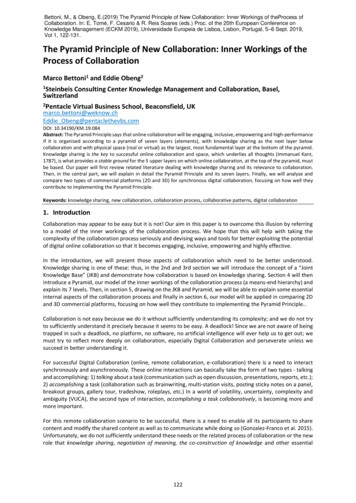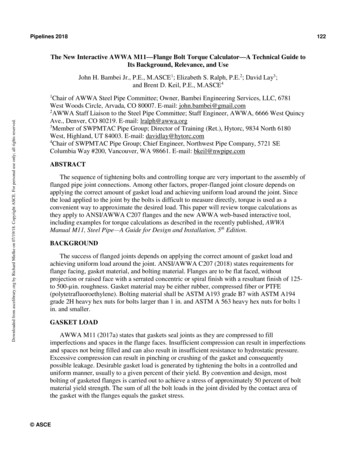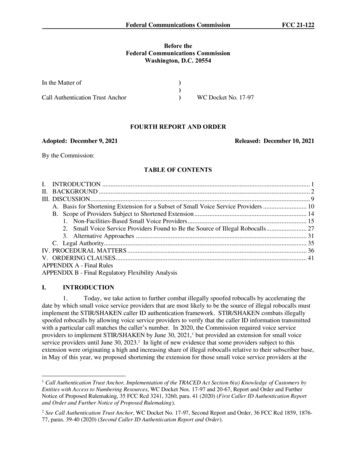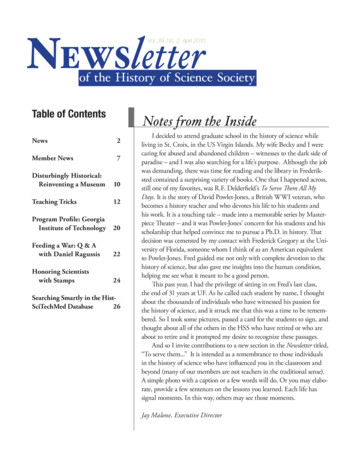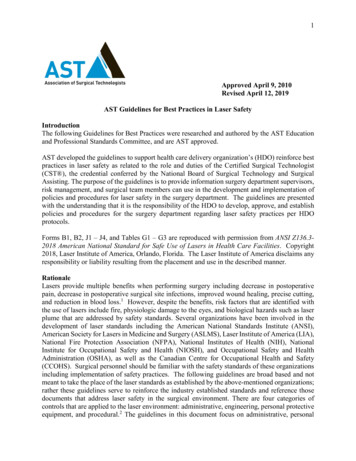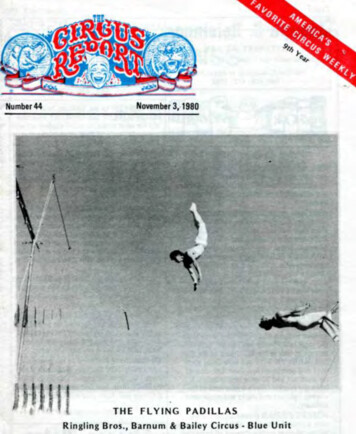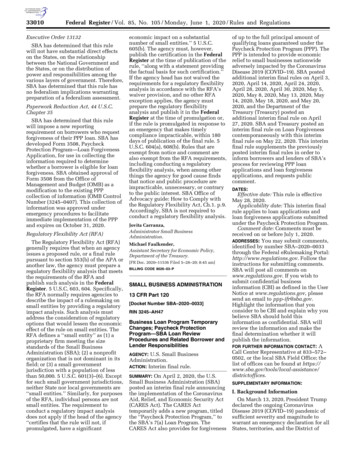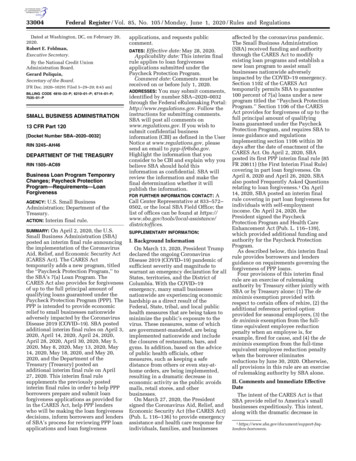
Transcription
38JADA, Vol. 122, April 1991
IS THERE A LINK BETWEENWATERAND OSTEOSARCOMA?To test the hypothesis thatfluoride is a risk factor forosteosarcoma, a case controlstudy compared thecomplete residentialfluoride histories o fosteosarcoma patients withmatched hospital-basedcontrols. Fluoridation wasnot found to be a risk factorfor osteosarcom a in thestudy population. The trendin the data from this smallsample study suggests thehypothesis that a protectiveeffect may exist against theformation o f osteosarcomafor individuals consumingfluoridated water.S H E IL A M . M C G U IR E , D.D .S.,M .S.E LE A N O R D. V A N A B L E , ED.D.M IC H A E L H. M C G U IR E , M .D .J O S E P H A. B U C K W A L T E R , M .D.CHESTER W . DO UGLASS,D .M .D ., PH .D .Q he “equivocal evidence” of a link between fluoride ingestion and theformation of osteosarcom a in a small percentage of male rats thatreceived high doses of fluoridated w ater (100 and 175 ppm NaF) wasreported in 1990.1Inferences on hum an risk of fluoride carcinogenicityare difficult a t best to obtain from animal studies.Our study reports findings from a hum an population-based analyticalstudy of osteosarcom a patients and matched controls. The relationship ofsystemic fluoride exposure from the ingestion of w ater from residentialsources to the occurrence of osteosarcoma was examined.An incorrect inference im plicating systemic fluoride carcinogenicityand its removal from our w ater systems would be detrim ental to the oralhealth of m ost Americans, particularly those who cannot afford to pay forincreasingly expensive restorative dental care.Osteosarcoma is a rare and painful prim ary m alignant bone tum ormost commonly occurring in children and young adults. Data2indicatethat tum ors of the bones and joints occur in less than one person in100 , 0 0 0 .The American Cancer Society estim ated there w ere 2,100 new cases ofbone sarcom as in 1989.3According to Maeyama,4osteosarcom a incidencevaried with age; 35.7 percent of all the m alignant bone tum ors occurringin the first decade of life were osteosarcomas, rising to a peak of 69.6percent in the second decade and decreasing thereafter to 24.5 percentand 4.3 percent respectively in the third and fourth decades. Malepatients predom inated, with a ratio of three males to two females.Radiation,57viral action,8-9genetic factors10and other exogenous factorshave been implicated in the development of osteosarcom as.11Radiationinduction of osteosarcom a is at present an accepted principle. A recentreview of the epidemiology of bone sarcomas, however, reportedconflicting study results for all other etiologic agents. Fluoride ingestionwas not linked to osteosarcomas in the m ost recent review.11Hoover and others at the National Cancer Institute com paredstandardized bone cancer m ortality rates in fluoridated and nonJADA, Vol. 122, April 199139
fluoridated counties in the UnitedStates.12No change in bone cancerm ortality took place over the 15year comparison. In addition,standardized overall cancerm ortality rates have beencompared for fluoridated and non fluoridated communities.13'14Noneof the studies uncovered asignificant increase in hum ancancer incidence or m ortality as aresult of the im plem entation ofcom m unity fluoridation.According to the CongressionalCommittee on Intergovernm entalRelations and Human Resources,questions lingered about therelationship between fluorideingestion and osteosarcomas.The National ToxicologyProgram was directed to conductan animal toxicity study to test thecarcinogenicity of the fluoride ion.The NTP concluded and the Boardof Scientific Counselors’ TechnicalReports Review Panel concurredth at its two-year studies showedonly “equivocal evidence ofcarcinogenic activity” in male ratsand “no evidence of carcinogenicactivity in female rats or in male orfemale mice.”1(Equivocal evidenceis a category for uncertain findingsdem onstrated by studies that areinterpreted as showing a marginalincrease of neoplasms that may bechemically related.)Findings on the molecularexplanation for the initiation of anosteosarcoma tum or from fluorideexposure could not be found in aTABLE 1F L U O R ID E E X P O S U R E A T OR A B O V E R E C O M M E N D E DO D C LE V E L SControlsMore than 1/3 ofLess than 1/3 oflife at 0.7 ppmlife at 0.7 ppmCasesMore than 1/3 oflife at 0.7 ppmLess than 1/3 oflife at 0.7 ppmO R R R 0.14Z c2“ 3 1D E R IV A T IO N O F A V E R A G E L IF E T IM E F L U O R ID EE X P O S U R E (IN P P M )Example:Case(11 years x 0.8 ppm) (7 years x 1.0 ppm) .87 ppm18Control(15 years x 0.3 ppm) (3 years x 1.0 ppm) .42 ppm18JADA, Vol. 122, April 19911739 5 % C l 0 .0 2 , 1.22refereed journal. However, them echanism of fluoride’s action tostrengthen osteal tissue is relatedto its ionic capabilities. The majorcom ponent of osteal tissue and themajor strengthening material inteeth is structural hydroxyapatite,Ca5(P04)30H.When ionic fluoride enters thehydroxyapatite lattice, a dynamicexchange of F for OH occurs inportions of the structure. Theresulting fluorapatite tightly bindsthe fluoride, strengthening thestructure and rendering it lesssusceptible to dissolution inorganic acids.15Strengthening canoccur either throughincorporation of F ions during thetissue m ineralization phase oftooth or bone development,16orexchange of ions after formationhas occurred.17Because of its strengtheningaction, fluoride has been widelyF IG U R E 14011accepted as the responsible agentfor dram atic declines in the toothdecay rates of U.S. children andadolescents.1819Studies of matchedpairs of fluoridated and non fluoridated communitiesestablished the principle thatdecay rates could be reduced by upto 70 percent through the use offluoridated community water.20Current reduction rates areestim ated to be between 20percent to 30 percent.21Adisruption in the delivery offluoride through municipal watersystems would increase decayrates over time.In one study, fluoride wasremoved from a com m unity watersupply after 11 years offluoridation. The DMFS scoreswere recorded for second-gradechildren at the time ofdefluoridation and second-gradechildren six years later. Sixtyseven percent more children at thetime of defluoridation were cariesfree w hen compared with thesecond graders six years later.22Linkage of fluoride ingestionand cancer initiation could resultin a large-scale defluoridation ofm unicipal w ater systems underthe Delaney clause. (One aspect ofthis Environm ental ProtectionAgency clause prevents theaddition of carcinogenic agents to
the nation’s w ater supply.) To testthe hypothesis th at fluoride is arisk factor for osteosarcoma, thiscase control study compared thecomplete residential fluoridehistories of osteosarcom a patientswith m atched hospital-basedcontrols of similar age, gender andcounty of residence.METHODSOsteosarcoma patients wereidentified from the University ofIowa Cancer Registry and themedical records of the Division ofOrthopedics, St. Josephs Hospitalin Omaha, Neb. Each sourcerecorded birth date, the age atdiagnosis, gender and county ofresidence at diagnosis for eachcase. Eligible cases w ere patientsdiagnosed between 1980 to 1990and younger than 40 at diagnosis.Non-radiation inducedosteosarcom a occurspredom inantly in the first fourdecades of life. Osteosarcomapatients with any prediagnosishistory of the known risk factor,radiation therapy, were excluded.In addition, patients with a historyof kidney dialysis were excluded asthey choose to drink deionizedw ater for medical reasons.The University of Iowa and St.Josephs hospitals identified 44eligible cases. Correct addressescould not be ascertained for sevencases; two patients had receivedpre-diagnosis radiation therapyand one medical record could notbe found. Contact with theTABLE 2A V E R A G E L IF E T IM E E X P O S U R EControlsHigh 0.7 ppmCasesHigh 0.7 ppmLow¿0.7 ppm0 R RR Q.33Low¿0.7 ppm9265X c 11295% Cl 0.04,2.50rem aining 34 eligible patients wasinitially m ade by mail with a letterof explanation of the researchgoals of the study from theappropriate orthopedicdepartm ent chairman.Hospital-based controls frompatients of the appropriateorthopedic departm ent werem atched by age, gender andcounty of residence at time ofdiagnosis. The Midwest states—Iowa, Illinois and Nebraska, inparticular—are geographicallydivided into m any small counties,for example, 99 in Iowa. Mostcounties are rural w ith relativelyfew dom inated by an urbanindustrial area. The advantage ofmatching on the county ofresidence variable includes greaterlikelihood of socio-economic statussimilarity and absence of biasrelated to the complex referralprocess that precedeshospitalization.23Following a localcustom, residents of Iowa andNebraska typically identifythemselves as a resident of aparticular county.Cases and controls wereexcluded with identical criteria:any history of radiation therapyand patients with a history ofkidney dialysis. The factor underinvestigation—ingestion ofresidential fluoridated w ater—isJADA, Vol. 122, April 199141
TABLE 3C H IL D H O O D E X P O S U R EControlsMore than 1/3 ofchildhood at 0.7 ppmCasesMore than 1/3 ofchildhood at 0.7 ppmLess than 1/3 ofchildhood at 0.7 ppmOR RR 0.33Xc2 u 29RESULTS6JADA, Vol. 122, April 199159 5 * 0 1 0.04,2.50not associated w ith any othermedical condition or risk factor.Therefore, no other categories ofdisease were deliberately includedor excluded in the hospital controlgroup.As each osteosarcom a case wasto be m atched to a control patient,a 1:1 ratio of cases to controls wasrequired. Initially, an attem pt wasm ade to contact two controls foreach of the 34 cases with a letterexplaining th e study’s researchgoals from the appropriateorthopedic departm ent chairman.Because there was no age andcounty of residence m atchedcontrol for seven of the cases, 27pairs of cases and controls wereenrolled.The 27 cases were interviewedby telephone forthe followinginformation: allresidentialaddresses of theosteosarcomapatient beforeDr. Sheila M cG uire isdiagnosis;an Oralyear(s) lived atEpidemiology[ Fellow , Harvardeach address;School of D en talaccess toM edicine, 188municipal orLong wood A ve.,Boston, 0 2 1 1 5 .well w ater atAddress req uests foreach address;[ reprints to Dr. M cG uire.and bottled42Less than 1/3 ofchildhood at 0.7 ppmwere provided by mail to theparticipants with access to wellwater. The participants wererequested to retu rn a well watersample for analysis of fluoridecontent by the University of IowaHygienics Laboratory.water use. The same procedurewas followed to ascertainresidential histories from them atched controls.Fluoride levels (in ppm ) formunicipalities supplying w ater tothe cases andcontrols wereascertained fromthe m ost recentCenters forDisease ControlFluoridationCensus in theyears identified.If a case orcontrol lived in am unicipalitybeforeadjustm ent offluoride levelslisted in thecensus or in am unicipality notlisted in thecensus, theappropriatestate’sD epartm ent ofNaturalResources wascontacted for thecorrect pre adjusted level offluoride. Watersample tubesContact by telephone wassuccessful for all 27 osteosarcom acases and their controls. One caserefused to participate and fourcases could not supply sam ples ofwell w ater from previousaddresses. Therefore, the analysiswas conducted using the fluorideexposure inform ation gathered on22 m atched-pair cases andcontrols.Thirteen pairs were males andnine were females, consistent withthe national figures. Additionally,
as in thenational figures,thepreponderanceof this study’sosteosarcomapatients, 14cases, werediagnosed in thesecond decadeof life (11 to 20).Three casesw ere children 10 years old oryounger, three cases were 21 to 30and two cases were in their 30s.Each participant had lived at anaverage of two differenttow ns/farm s per lifetime.Therefore, complete residentialfluoride history was to besum m arized and com pared bythree methods. The first m ethodcom pared years spent at or abovethe recom m ended levels offluoride as set by the CDC, thesecond m ethod collapsed the datainto a lifetime average exposure,and the third com pared exposureduring childhood and earlyadolescence—the years of bonedevelopment.The first m ethod of analyzingthe data was to com pare years thecases and their controls spent atETis no association betweenresidential fluoridated w aterexposure and osteosarcoma,nam ely an odds ratio (OR) estim ated relative risk (RR) 1.For this study population, the casein one pair lived more than 1/3 ofhis or her life in tow ns/farm s withnrbnum ber of pairs in w hich only the case had ahigh average fluoride exposure levelOR - num ber of pairs in w hich only the control had ahigh average fluoride exposure levelfluoride levels 0.7 ppm while them atched control lived less than 1/3of his or h er life at sites 0.7 ppm.Conversely, the controls inseven pairs lived more than 1/3 oftheir lives in towns/farm s withfluoride levels 0.7 ppm while thepaired cases lived less than 1/3 oftheir lives at sites 0.7 ppm. Theodds ratio using this m ethod ofassessing exposure is .14. Theconservative Yates continuitycorrected chi-square test form atched paired data (%c2) wasused to test the statisticalsignificance of the estim ate of them agnitude of the associationnum ber of pairs in w hich only the case livedmore th a n 1/3 of life a t sites w ith 0.7 ppmnum ber of pairs in which only the control livedmore than 1/3 of life a t sites with 0.7 ppmor above the recom m endedoptimal level set by CDC, 0.7 ppm.24The odds ratio of disease(osteosarcom a) associated withexposure (years spent atrecom m ended levels offluoridation) was calculated asshown (A).The null hypothesis is that thereConfidence intervals including 1support the hypothesis th at theconsum ption of residentialfluoridated w ater is not a riskfactor for the occurrence ofosteosarcom a in this studypopulation.A lifetime average exposure wasbetw een fluoride history andosteosarcoma. The Xc was n tsignificant ( c2 3.1, P 0.05).Therefore, we failed to reject thenull hypothesis.The corresponding confidenceinterval (Cl) was calculated usinga test-based approach.25The 95percent Cl is 0.02,1.22 (Table 1).calculated for each participant bymultiplying the num ber of yearslived at an address by theaddresses’ fluoride level sum m edover a lifetime and divided by age(Figure 1). The average exposurefor the case was com pared to theaverage exposure of the m atchedcontrol to produce an odds ratio(Table 2). Exposure to highfluoride level was defined as 0.7ppm lifetime average exposure.Exposure to low fluoride levelwas defined as 0.7 ppm. The oddsratio for this m ethod wascalculated as shown (B).Again, the null hypothesis isthat there is no associationbetween residential fluoridatedw ater exposure and osteosarcoma,OR l.For this m ethod of comparison,the case in two pairs had a highaverage fluorideexposure andthe m atchedcontrol had alow averageexposure. Thecontrol in sevenDr. Douglass ispairs had a highaverage fluoride professor and chair,D ep artm e nt ofexposure and its Dental C areAdm inistration,paired case hadH arvard School ofa low averageD en tal M edicine,Boston.fluorideJADA, Vol. 122, April 199143
exposure. Therefore, the odds ratiois 0.33 w ith a Yates continuitycorrection Xc test, x c2 1-125, P .05, Cl .04,2.5 (Table 2). Theanalysis of this com parison alsoshows th at residentialfluoridated w ater is not a riskfactor for the occurrence ofosteosarcoma.Lastly, the data were separatedand analyzed in term s ofchildhood and adolescent years(birth-15) spent at residences at orabove the recom m ended optimallevel for fluoridated water, 0.7ppm. Only the fluoride exposurefor the first 15 years of life for thecases and the controls was used tocalculate the odds ratio shown(C).Only the cases in two pairs livedm ore than 1/3 of the first 15 yearsof th eir lives in tow ns/farm s withfluoride levels 0.7 ppm, whiletheir m atched controls spent lessthan 1/3 of the first 15 years oftheir lives at sites with 0.7 ppm(Table 3). Conversely, in six pairs,only the controls lived more than1/3 of the first 15 years of theirchildhood a t sites with fluoridelevels 0.7 ppm while their pairedcases spent less than 1/3 of the first15 years of their lives at sites 0.7ppm.Therefore, the odds ratio is 0.33with a Yates continuity correctionXc‘ test, Xc 1-125, P .05, Cl .04,to be a risk factor for theoccurrence of osteosarcoma.D IS C U S S IO NOsteosarcoma is a rare diseaseoccurring prim arily in the seconddecade of life. The matched-paircase control study reported hereconsists of an analysis of only 22m atched pairs. A point estim ate ofan odds ratio 1, indicating a linkbetween fluoridated w ater andnum ber of pairs in w hich only the case livedmore th an 1/3 of the first 15 years of life a t sites 0.7 ppmOR num ber of pairs in which only the control livedmore th an 1/3 of the first 15 years of life a t sites 0.7 ppm2.5 (Table 3). For this m ethod ofcomparison, residentialfluoridated w ater exposure atlevels 0.7 ppm during the years ofbone developm ent does not appear44JADA, Vol. 122, April 1991osteosarcoma, did not exist in anyof the three m ethods of analysisused in this study. Because of thesmall sample size, the confidenceintervals were broad bu t theytended to stay close to OR 1, thusrejecting the hypothesis thatfluoridation is a risk factor forosteosarcomas.The findings provoke interest ingreatly increasing the sample sizeto further define and clarify therelationship betweenosteosarcom a and fluorideexposure. One unexpectedhypothesis was generated by thedata. With point estim ations of allthree odds ratios less than 1,perhaps an inverse relationshipmay exist; th at is, th at fluoridationatrecom m endedlevels mayprovide aprotective effectagainst theAformation ofDr. M ichael M cGuireosteosarcoma.is professor andc hief, Division ofEvidence existsO rthopedic Surgery,to support suchC reighton UniversitySchool of M edicine,a hypothesis.Om aha, Neb.Vogel,26Obe27
and SlacikErben28havereportedhistologicalstudies showingth at fluorideD r. Vanable ismay provide anvisiting associateantim utagenprofessor, Harvardeffect.School of DentalM ed ic in e, Boston.A nationwide,m ulti-centeranalytical study to increase theprecision of our initial findingsand pursue the hypothesis that theingestion of fluoridated w ater mayprovide protection against theoccurrence of osteosarcoma hasbeen initiated by the authors. Thislarger study will also include thecollection of any history ofparticipation in school-basedm outhrinsing programs or use ofsupplem ental fluoridetablets/drops in addition tocomplete residential fluoridehistory.C O N C L U S IO NIn a case-control study ofosteosarcoma patients andhospital-based matched controls,the ingestion of fluoridated waterwas not found to be a risk factor forosteosarcoma. Hence, no link wasfound between the occurrence ofosteosarcoma and ingestion ofresidential fluoridated w ater overthe course of a lifetime or duringthe years of bone development.Given present knowledge, everyeffort should be made to continuethe practice of fluoridatingcommunity w ater supplies. The authors thank the following for technicalan d creative support: Dr. C hristopher Fox, RitaMcGuire, Carolyn Rauch, B eth H enderson andJean ette Marsh.1. National Toxicology Program. Toxicology andcarcinogenesis of sodium fluoride in F344/N ratsan d B6C3F1 mice. Technical R eport Series 393,NIH Publication No. 90-2848,1990.2. Surveillance epidemiology end resultsincidence and m ortality data: 1973-77. Natl CancerIn st Monogr 1982;57:14,149,183.3. A m erican Cancer Society: C ancer facts andfigures -1989. New York: American CancerSociety;1989:8.4. Maeyama I. Bone tum ors in Japan. ClinO rthop 1984;184:65-70.5. M artland HS, H um phries RE. Osteogenicsarcom a in dial painters using lum inous paint.A rch Pathol 1929;7:406-17.6. S teiner GC. Postradiation sarcom a of bone.C ancer 1965;18:603
Dr. Sheila McGuire is an Oral Natural Epidemiology [ Fellow, Harvard School of Dental Medicine, 188 Long wood Ave., Boston, 02115. Address requests for [ reprints to Dr. McGuire. water use. The same procedure was followed to ascertain residential histories from the matched controls. Fluoride levels (in ppm) for municipalities supplying water to
